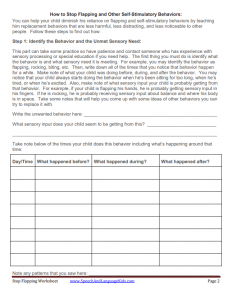Replacing Unwanted Stimming Activity
Description: Self-stimulatory behaviors, also known as stimming, are behaviors that occur when a child has unmet sensory needs. For example, when I have to sit still at my desk for too long, I’ll start bouncing my foot, shifting in my seat, and I may get up to go get a drink of water frequently. These things help me feel good in my body because they provide the sensory input I need. However, sometimes, stimming behaviors may become harmful or may interfere with someone’s life. In those situations, it can be good to find a replacement behavior that gets that same sensory need met.
*** PLEASE NOTE: I am not saying that we should never allow a child to stim. Stimming is necessary for some children and we should not aim to change a child’s stimming just because we don’t like it. This is specifically for if a child is hurting himself or others with his stimming (like biting) or if it is impacting his ability to function in every day life (such as a teenager who wants to choose less noticeable stims because he realizes that he “looks funny”).
For this, you’ll want to start by identifying what the stimming behaviors are and write down when they occur. Look for patterns in your observations that may lead to hypotheses about why the child is doing them. If you are working with an older child who can communicate well, ask if he/she has any insight about why that particular stimming behavior feels good.
Next, you’ll want to choose on behavior to target and take a guess at what sensory input the child is getting from that behavior. Find an appropriate replacement behavior that gets that need met as well but may be safer or less distracting. For this part, you’ll need input from your occupational therapist. This is not something that we should undertake alone. Where our role comes in is with the communication part of this. We can help with ensuring that the child understands the replacement behavior and knows how to communicate when he has that need, if communication is needed. For example, if the replacement behavior is to get up and get a drink of water, we can help the child understand how to ask for a break and help him/her learn to initiate that communication instead of resorting back to the harmful behavior.
You can download our “replacing unwanted stimming behaviors” workbook using the link below, or go through this process on your own!
Click Here to Join the Membership and Download this Activity Right Now!


